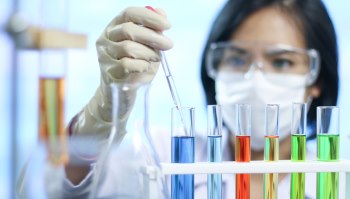An Introduction to Biologic Therapies
 Biologic therapies, as the name implies, are products derived in some way from living organisms. These treatments include a variety of vaccines, blood components and proteins that are either derived from natural sources or are synthesized in the laboratory. Biologic therapies are particularly relevant to patients with allergic and immunologic diseases.
Biologic therapies, as the name implies, are products derived in some way from living organisms. These treatments include a variety of vaccines, blood components and proteins that are either derived from natural sources or are synthesized in the laboratory. Biologic therapies are particularly relevant to patients with allergic and immunologic diseases.
Vaccines
Vaccines constitute one of the most important breakthroughs in medical history and are responsible for protecting large populations from potentially deadly viral and bacterial infections. Edward Jenner created the first living vaccine in 1796 by administering fluid taken from a cowpox blister to a human being, which resulted in protection from smallpox infection.
Today, there are a number of vaccine types which help protect against a large number of infectious organisms. Live attenuated vaccines use a live but weakened form of the microorganism (example: measles, mumps, rubella), while killed vaccines use organisms which have been inactivated in the laboratory (example: influenza). Toxoid vaccines contain a toxin which is normally made by a microorganism; these vaccines block the harmful, or toxic, effects of the infection (examples: diphtheria and tetanus). Bio-synthetic vaccines contain man-made substances that are similar to parts of the actual microorganism (example: Haemophilus influenzae type B conjugate vaccine).
Vaccines directed against allergenic substances, such as dust mites, animal danders, molds and pollens, also have a long history as effective treatments for chronic allergic diseases such as allergic rhinitis and asthma. Most recently, scientists are now developing effective vaccines against certain types of cancer (example: melanoma), with many more likely to follow in the future.
Blood Components
Whole blood is composed of cells (red and white) and liquid plasma; blood is an approximate 50:50 mix of each. The most commonly used blood product is an infusion of packed red blood cells, which are administered to patients who have experienced acute blood loss. While plasma contains no cells, it is rich with blood proteins, and the three most important are albumin, globulins and fibrinogen. Globulins include immunoglobulins, which are antibody proteins produced by special immune cells (B-lymphocytes) and are key components in preventing infection. These immunoglobulins can be separated into immunoglobulins (Ig) A, M, G, D and E and are referred to as IgA, IgM, IgG, IgD, and IgE. Purified IgG can be separated from the plasma of large numbers of normal, donor individuals who have been carefully screened to ensure that they are healthy and are not carrying any infectious organisms. This purified IgG contains a broad range of specific antibodies to many different types of bacteria and viruses and is most commonly administered to patients with various types of immunoglobulin deficiency diseases.
Proteins
Proteins useful for the treatment of diseases include a small number of naturally-occurring proteins called cytokines. Cytokines are proteins which the body uses to both activate and suppress immune cells which are involved in immune regulation and protection against infections. Interleukin-2 (Aldesleukin) is an approved therapy for certain cancers, while interferon gamma and interferon alpha are used as treatments for specific types of infectious illnesses and immune deficiency states.
Monoclonal antibodies, or MAbs, are laboratory-produced antibodies that target specific proteins that are involved in disease processes. These proteins may be floating freely in the plasma or may be found on cells. To create MAbs, researchers typically inject mice with a target protein found in humans. Once the mice begin to make antibodies to this foreign, human protein, the antibody-producing B-lymphocyte cells from the mice are harvested. These mouse B-lymphocytes are then fused in the laboratory to special cells to create a long-lasting hybridoma, which divides repeatedly to produce identical daughter cells, or clones. These single clone, or “monoclonal”, antibodies, are all identical to one another and can be produced in large quantities.
Unfortunately, once these mouse-derived antibodies were administered to humans, the antibody would act as a foreign protein, or antigen, and cause the patient to produce their own antibodies against this antigen. This immune response by the patient would undoubtedly lead to neutralization of the mouse antibody, reducing its efficacy, as well as lead to probable severe adverse effects. To get around this problem, mouse antibodies are “humanized” by replacing as much of the mouse portion of the antibody as possible with human portions. Some examples of therapeutic monoclonal antibodies in allergic diseases include omalizumab to treat allergic asthma and chronic urticaria, mepolizumab, benralizumab and reslizumab to treat certain kinds of asthma, and dupilumab to treat atopic dermatitis. More recently, newer technologies are allowing scientists to create fully human monoclonal antibodies, which leads to enhanced effectiveness and reduced risk of adverse effects.
There are substantial ongoing research efforts in the development of biologic therapies for allergic and immunological diseases and this is paving the way for future treatment options in individuals suffering from these conditions.
Find out more about allergic conditions.
The AAAAI's Find an Allergist / Immunologist service is a trusted resource to help you find a specialist close to home.
10/31/2023